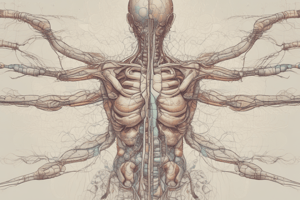Podcast
Questions and Answers
What are the basic functions of the nervous system?
What are the basic functions of the nervous system?
Recognizing changes in the internal and external environments, processing and integrating environmental changes, reacting to changes by producing an action or response.
The peripheral nervous system (PNS) transmits signals between the CNS and the rest of the body and is made up of __________ and __________.
The peripheral nervous system (PNS) transmits signals between the CNS and the rest of the body and is made up of __________ and __________.
Sensory Neurons, Motor Neurons
Name the two primary divisions of the autonomic nervous system.
Name the two primary divisions of the autonomic nervous system.
Sympathetic Division and Parasympathetic Division.
What is the primary function of the sympathetic division?
What is the primary function of the sympathetic division?
The parasympathetic division is responsible for 'fight or flight' responses.
The parasympathetic division is responsible for 'fight or flight' responses.
What neurotransmitter is primarily associated with the parasympathetic nervous system?
What neurotransmitter is primarily associated with the parasympathetic nervous system?
Which of these receptors are located at the ganglionic synapse?
Which of these receptors are located at the ganglionic synapse?
What are the two subclasses of parasympathomimetics?
What are the two subclasses of parasympathomimetics?
Muscarinic receptors are affected by __________ that bind to these receptors.
Muscarinic receptors are affected by __________ that bind to these receptors.
Flashcards are hidden until you start studying
Study Notes
Basic Functions of the Nervous System
- Recognizes changes in internal and external environments.
- Processes and integrates perceived environmental changes.
- Reacts to changes by producing actions or responses.
Divisions of the Peripheral Nervous System (PNS)
- PNS transmits signals between the Central Nervous System (CNS) and the body.
- Consists of:
- Sensory Neurons: Carry signals to the CNS from sensory organs.
- Motor Neurons: Carry signals from the CNS to muscles and glands.
- Somatic Nervous System: Controls voluntary movements by activating skeletal muscles.
- Autonomic Nervous System (ANS): Controls involuntary responses; influences organs, glands, and smooth muscles.
- Sympathetic Division: Prepares body for stressful activities ("fight or flight"), featuring adrenergic receptors
- Parasympathetic Division: Dominates during "rest and digest," directing maintenance activities; utilizes cholinergic receptors.
Actions of Autonomic Nervous System Divisions
-
Sympathetic Division ("fight or flight"):
- Dilates pupils (mydriasis).
- Inhibits salivation.
- Accelerates heart rate and contractility.
- Dilates bronchioles.
- Inhibits digestion.
- Stimulates glucose release.
- Secretes epinephrine and norepinephrine (causing peripheral vasoconstriction).
- Relaxes bladder.
- Stimulates ejaculation (male) and orgasm (female).
-
Parasympathetic Division ("rest and digest"):
- Constricts pupils (miosis).
- Stimulates salivation.
- Slows heart rate and contractility.
- Contracts bronchioles.
- Stimulates digestion.
- Activates gallbladder function.
- Contracts bladder.
- Stimulates erection (male) and vaginal lubrication (female).
Information Transmission in the Nervous System
- Action travels along the first neuron until it reaches a synapse (the junction with a second neuron).
- The ganglionic synapse occurs in ganglia outside the CNS.
- Preganglionic neurons carry impulses away from the spinal cord.
- Postganglionic neurons receive impulses at the ganglionic synapse.
- Two primary neurotransmitters in the ANS are:
- Acetylcholine (ACh): Main neurotransmitter of the PNS.
- Norepinephrine (NE).
Cholinergic Receptors: Nicotinic vs. Muscarinic
-
Nicotinic Receptors:
- Located at the ganglionic synapse in both divisions of the ANS.
- Bind ACh in both sympathetic and parasympathetic divisions and also in skeletal muscle.
-
Muscarinic Receptors:
- Found on target tissues influenced by postganglionic neurons in the PNS.
- Bind ACh in organs targeted by the PNS.
- Drugs affecting these receptors can cause significant effects, including tachycardia, hypertension, and increased digestive tract motility.
Classification of Cholinergic Drugs
-
Cholinergic or Parasympathomimetics:
- Stimulate the parasympathetic nervous system, producing "rest-and-digest" symptoms.
-
Cholinergic-Blocking Drugs or Anticholinergics:
- Inhibit the parasympathetic nervous system, causing effects opposite to cholinergics.
- Also referred to as parasympatholytics and muscarinic blockers.
-
Subclasses of Parasympathomimetics:
- Direct Acting: Bind directly to receptors.
- Indirect Acting: Enhance ACh activity by inhibiting its breakdown.
Studying That Suits You
Use AI to generate personalized quizzes and flashcards to suit your learning preferences.




